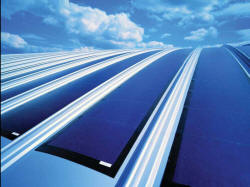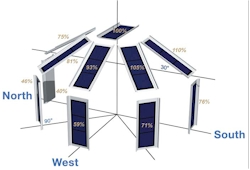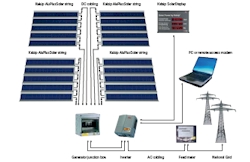|
Photovoltaics have the greatest documented
technical potential for generating electricity of all the renewable energy
sources in Europe. The trend is definitely in the direction of the so called
BIPV – Building Integrated Photovoltaics – and these can be integrated
directly as solar components with multiple functions such as sunshades,
facade cladding or roofing, thus affording other green benefits. |
 |
|
Photovoltaics (PV) represent an increasingly
important type of renewable energy, thanks to rising interest in and demands
on the environment and advances in solar technology supported by subsidised
programmes. |
|
The importance of PV in architecture is also
changing, the main criteria being the desire for design freedom and a
balanced appearance of the system. While PV thinking is usually strongly in
the direction of tilted, framed crystalline modules, which are difficult to
match with the preferences of many planners and architects, the trend today
is towards architectonically integrated systems that are generally based on
more modern, thin film technology. |
|
Applications |
|
Modern BIPV do not necessarily have to be the
aspect that determines the design for architecture. Quite the contrary.
Intelligent solar energy systems can be integrated in the planned
construction project such that they are easily visible or hidden, depending
on the customer’s wishes.In general, all roof surfaces facing southwest to
southeast in central Europe are suitable for PV applications. However, BIPV
can also be used for north-facing shallow-sloped roofs if the usable areas
of the shells in the roof and facade are designed to ensure optimum sunlight
exposure without shading. In case of doubt, computer-aided simulation can
help ascertain the right solution. |
| Thin
film modules are commonly employed in the integration of PV in buildings and
compared to the better known crystalline modules, have not just a
significant weight advantage. This technology is especially suitable for
weak or diffused light because the usual mounting supports for the modules
are no longer required. |
| In general, the
roof is the part that is most exposed to weather and environmental
influences. Classic, sustainable roof planning, with all the constructive
and physical requirements in terms of waterproofing and durability, must not
be neglected. |
 |
| Ideally therefore,
well-proven roof systems should be used where the PV cells/modules are
integrated into the roof skin but also where the original roof is
technically separate from the PV itself |
| The
number of metal or plastic flat or pitched roofs that satisfy this
requirement is increasing but the system used should fulfill the following
five criteria: |
- The roof system is supervised and
approved and its functions have been tried and tested on the market.
- Solutions that satisfy the relevant
standards and that have technically proven themselves are available for
all planning and implementation problems, especially in the case of
details and connections.
- The functioning (or as the case may be,
the failure) of the PV modules does not affect the structural and
physical properties of the roof.
- The BIPV system demonstrably fulfills
the requirements of protection class II (Electrical Safety during
Assembly and Operation) and IEC 61646/IEC 61215 (Suitability and
Durability of Photovoltaic Modules).
- The materials, construction and
implementation of the roof system ensure the proper operation of the PV
system over the expected PV service life. Current experience has shown
this is approximately 35 to 40 years. This also means future expected
maintenance or repair work should not affect the functioning of the PV
system or, in the worst case, lead to a failure.
|
| A
feature shared by BIPV thin film systems used today is the favorable energy
payback time. While the usual systems based on crystalline modules have an
energy payback time of about 10 years, that of current thin film systems is
approximately two years.The difference is based mainly on the more spared
use of the primary material - silicon. In the most commonly used module type
made of amorphous silicon (a-Si), the required silicon layer thickness is
less than 100th of the layer thicknesses in crystalline framed cells. This
property is also the reason for the malleability and flexibility of many
BIPV systems. |
| At the same time,
this characteristic means that the surface efficiency of thin film modules
is usually lower than the comparable values of crystalline modules. As a
result, a smaller system (ie. a lower kWp capacity) should be installed. |
 |
| Thin film modules
based on cadmium telluride (CdTe) are still not often used - they are
controversial due to the use of the heavy metal cadmium and stringent safety
and environmental regulations must be satisfied in the production phase. |
| In
technical circles, copper indium diselenide (CIS) modules have long been
considered as being a determining influence because higher efficiencies are
being targeted for the future. Until now however, the difficulty concerning
this module type has lain in setting up the very complex system technology
for mass production. |
| Dr
Jürgen Neuwald is director of new business and technology for Kalzip Ltd,
for more information see
www.kalzip.com |